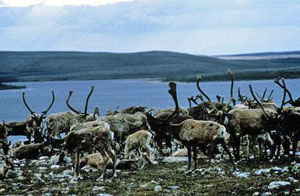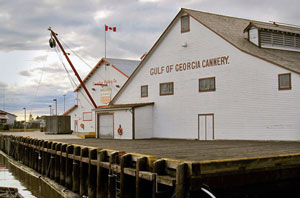Canada’s Rivers, Canada’s History
The Canadian Heritage Rivers System and Historic
Places
The rushing waters of Canada's majestic rivers have shaped the
land and its history. With June comes Canadian Rivers Day, a time
to celebrate the importance of our country's heritage rivers and to
reflect on their contribution to Canadian identity and history.
Many important rivers across Canada have been given national
recognition through the Canadian Heritage Rivers System (CHRS), a
collaborative program between federal, provincial and territorial
governments. Established in 1984, the CHRS is dedicated to
conserving and protecting Canada's river heritage for future
generations to enjoy. The program is committed to engaging the
public and encouraging Canadians to experience and appreciate what
the country's rivers have to offer, including stunning vistas,
thrilling adventures and captivating history. Today there are
forty-one rivers within the CHRS, and the list keeps growing!
Certain heritage rivers, such as the Kazan River in Nunavut, are
designated for their natural heritage. These pristine waterways are
valued for their undisturbed  beauty and have been designated to
ensure that their natural integrity is protected. Flowing 850
kilometres northward from the northern border of Saskatchewan to
Baker Lake, the Kazan River is set within a rugged landscape rich
in Aboriginal history and tradition. The Caribou Inuit lived on the
rocky banks of the Kazan for centuries, depending on its water and
on the
caribou migration that traversed nearby rough terrain. As an
important resource for the Caribou Inuit, the Kazan River has
escaped destructive human impact, leaving an unspoiled northern
landscape.
beauty and have been designated to
ensure that their natural integrity is protected. Flowing 850
kilometres northward from the northern border of Saskatchewan to
Baker Lake, the Kazan River is set within a rugged landscape rich
in Aboriginal history and tradition. The Caribou Inuit lived on the
rocky banks of the Kazan for centuries, depending on its water and
on the
caribou migration that traversed nearby rough terrain. As an
important resource for the Caribou Inuit, the Kazan River has
escaped destructive human impact, leaving an unspoiled northern
landscape.
Rivers in northern Canada are less likely to suffer from the
consequences of human development due to the more sparse
population. The Yukon River, part of which is a recognized Heritage
River, is an example of a river rich in history and natural beauty.
Stretching 3,200 kilometres from British Columbia to Alaska, the
Yukon was the primary means of transportation during the
1896 Klondike Gold Rush. The section designated as a Heritage
River in 1991 was dubbed "The Thirty Mile" by those who navigated
its treacherous rapids and shoals, and is representative of the
vegetation, wildlife and landforms found all along the Yukon River.
Visitors to the area can paddle in striking blue-green waters,
visit the historic town of
Dawson City, snap pictures of bears and migrating salmon, and
relive the
gold rush experience.
Other heritage rivers are designated for their cultural
heritage. Although the landscape surrounding these rivers is often
majestic, the impact of human contact has compromised their natural
integrity. Rivers near towns, cities or throughways have often been
altered by riparian development or engineering works, such as
bridges or dams. As sources of transportation and power, rivers are
important resources, and the interaction between people and their
waters are essential to maintain healthy lives. Cultural rivers
tell fascinating stories of human development and can be enjoyed as
heritage rivers while also maintaining ecological balance. The CHRS
helps maintain this delicate balance through the development of
management plans that define how these heritage values will be
presented and conserved for future generations.
The Rideau Waterway, for example, which encompasses the man-made
Rideau Canal, was nominated to the CHRS for its cultural
heritage. Designated in 2000,  the Rideau Waterway is a combination of
natural rivers and lakes, built canals, locks and dams, spanning
202 kilometres from Ottawa to Kingston, Ontario. Conceived and
constructed from 1826-1832 to aid in the defence of Upper Canada,
many of the lockstations along this historic waterway are intact
and functional, offering an exceptional understanding of
19th century
engineering works. Today, the Rideau Waterway remains an
important tourist destination, valued by visitors who come from
around the globe to visit this UNESCO World Heritage Site. In 2008,
the National Geographic Society declared the Rideau to be the
second most "authentic, sustainable destination" in the world.
the Rideau Waterway is a combination of
natural rivers and lakes, built canals, locks and dams, spanning
202 kilometres from Ottawa to Kingston, Ontario. Conceived and
constructed from 1826-1832 to aid in the defence of Upper Canada,
many of the lockstations along this historic waterway are intact
and functional, offering an exceptional understanding of
19th century
engineering works. Today, the Rideau Waterway remains an
important tourist destination, valued by visitors who come from
around the globe to visit this UNESCO World Heritage Site. In 2008,
the National Geographic Society declared the Rideau to be the
second most "authentic, sustainable destination" in the world.
The bucolic Hillsborough River, which nearly splits Prince
Edward Island in two, was also added to the CHRS in recognition of
its extensive cultural heritage. Overlooking the Hillsborough in
Charlottetown is the historic
Government House, an early 19th-century Neoclassical
residence built for the Lieutenant-Governor of the colony. During
the 1864 Charlottetown Conference, delegates and future Fathers of
Confederation were invited to Government House after their
discussions for elegant social soirées. The delegates arrived at
the conference from ships docked in the harbour of the Hillsborough
River. In 2013, Charlottetown will proudly host the 7th
Canadian River Heritage Conference, an opportunity for
international participants to share experiences, ideas and best
practices in the areas of river heritage conservation, restoration,
science and education.
The Grand River is the largest river in southern Ontario. This
award-winning Canadian Heritage River flows 300
kilometres from its source near Grand Valley into Lake Erie. In
2000, the Grand River was recognized with the Thiesse International
Riverprize in Australia as the best managed river in the world,
based on its Canadian Heritage River Management Plan. As Upper
Canada opened its interior to settlers after the War of 1812, the
Grand lived up to its name. Stately mansions, expansive farms and
industrial towns lined the inland waterway. The historic places
that have survived along the Grand River reflect the diversity of
cultures that have settled along its banks. Archaeological sites
speak to aboriginal occupation dating back 10,000 years, while such
places as the
Waterloo Pioneer Memorial Tower commemorate the influx of
Pennsylvania-German immigrants to the area during the early
19th century.
Chiefswood, an Italianate villa built near  the river by Mohawk Chief George Henry
Martin Johnson in 1853-1856, is said to have represented a bridge
between the Six Nations and white settlers.
Ruthven Castle, a dignified Greek revival style villa set
on a high point of land overlooking the Grand, is representative of
the picturesque country estates built in area by affluent families
in the 18th and 19th centuries. Fortunately,
for travellers along the Grand - whether canoeists or Sunday
drivers - the Grand River Conservation Authority has created an
impressive
searchable database of the cultural resources using some of the
CRHP's SoS information.
the river by Mohawk Chief George Henry
Martin Johnson in 1853-1856, is said to have represented a bridge
between the Six Nations and white settlers.
Ruthven Castle, a dignified Greek revival style villa set
on a high point of land overlooking the Grand, is representative of
the picturesque country estates built in area by affluent families
in the 18th and 19th centuries. Fortunately,
for travellers along the Grand - whether canoeists or Sunday
drivers - the Grand River Conservation Authority has created an
impressive
searchable database of the cultural resources using some of the
CRHP's SoS information.
The Fraser River is the largest river in
British Columbia and the longest river in the Canadian Heritage
Rivers System at 1375 kilometres in length. The river flows from
Mount Robson Provincial Park in the Rocky Mountains to its outlet
in the Strait of Georgia, and its watershed is home to over half of
British Columbia's population. Located at the river's mouth
is the
Gulf of Georgia Cannery, a large complex of wooden buildings
which are an illustration of industrial fish processing and canning
during the  first half
of the twentieth century. Designated for its outstanding natural,
historical, and recreational value, the Fraser River is best known
in the world for its salmon. With the most productive salmon
fishery in the world, the Fraser River has been a focal point in
sustaining a comfortable lifestyle for centuries, particularly for
the First Nations. With settlement, industries and urban
areas grew along the river to the point where today the economic
activity within the Fraser River Basin accounts for 80% of the
provincial and 10% of the national gross domestic product.
first half
of the twentieth century. Designated for its outstanding natural,
historical, and recreational value, the Fraser River is best known
in the world for its salmon. With the most productive salmon
fishery in the world, the Fraser River has been a focal point in
sustaining a comfortable lifestyle for centuries, particularly for
the First Nations. With settlement, industries and urban
areas grew along the river to the point where today the economic
activity within the Fraser River Basin accounts for 80% of the
provincial and 10% of the national gross domestic product.
Rugged and untamed, or pastoral and calm,
Canadian Heritage Rivers reflect the rich history and diverse
nature of the country. While many heritage rivers are remote and
difficult to reach many others are easily accessible from major
Canadian cities. Along many of these rivers, there are historic
places listed on the CRHP to visit and appreciate. Take the time to
enjoy our heritage rivers. They are an important and meaningful
part of Canada's history and landscape.